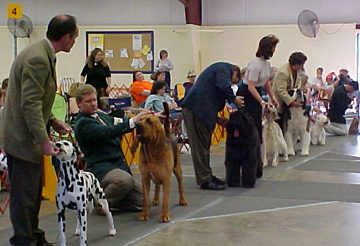COVER ~ CONTENTS ~ ARCHIVES ~ CREDITS ~ LINKS ~ BACK COVER ~ CONTACT US
NEXT PAGE
PAGE 2
A respected dog person of long standing approached me with this statement while at a seminar. “A judge CAN NOT GO WRONG by putting up winners conforming to the majority of the type of dogs in the ring on a given day.” My response was “Surely not!” Well, I believe it now! After observing an all breed judge from ringside, I watched two outstanding individuals “walk” because they looked different from the rest of the short neck, sickle hock, smaller than average dogs lacking side gait that toddled around the ring like fuzzy little caricatures of the breed.
This strange “look alike” perspective takes over in many breed rings and not just among judges. Asking a breeder what their standard said about head planes, the response was: “What are parallel planes?” We discussed the occipital bone, short and medium muzzles, balanced heads, etc. Reading a standard and applying it can be two different things.
This strange “look alike” perspective takes over in many breed rings and not just among judges. Asking a breeder what their standard said about head planes, the response was: “What are parallel planes?” We discussed the occipital bone, short and medium muzzles, balanced heads, etc. Reading a standard and applying it can be two different things.
It is a "Judas Kiss" to any breed when a judge puts up a dog simply because it looks like the majority in the ring. It encourages people to breed to “winners” rather than to a breed standard. In judge’s education, they address soundness but type takes priority. Educators assume that new applicants understand structure and corresponding movement. Type without soundness is as detrimental to a breed as soundness without type. A bad front and bad rear working in sequence produces “balance”. Do two wrongs make a right? The goal is “a balance between type and soundness”. A breed must be able to walk to the water bowl without falling over its own feet!
This brings us to the next question. Are not judges “protectors of the breed standards?” Judges education is NOT at fault. Perhaps the problem is what some judging applicants do NOT bring to the table! It is a privilege to pass judgment on a breed but one has the responsibility of understanding “Basic Dog 101”. The AKC’s required anatomy test neither assures someone’s knowledge nor is it any guarantee a judge has the ability to analyze structure and movement.
This brings us to the next question. Are not judges “protectors of the breed standards?” Judges education is NOT at fault. Perhaps the problem is what some judging applicants do NOT bring to the table! It is a privilege to pass judgment on a breed but one has the responsibility of understanding “Basic Dog 101”. The AKC’s required anatomy test neither assures someone’s knowledge nor is it any guarantee a judge has the ability to analyze structure and movement.

Judges should have the ability to articulate why one dog wins over another. So is that why they make terminology common among standards - to make it easier for judges? If anyone can describe a bulldog and an afghan using the same language, please step forward. Removing the “point system” from the old standards has had a negative affect. In a final decision between two comparable individuals, one has an idea where to hang their hat regarding prioritizing.
Some breeder judges today send dogs with a handler giving little thought as to their quality or future effect on a breed. Shouldn’t breeder judges be especially careful to send correct dogs for public observation? Breeders have a responsibility to put out “the best of the best” rather than a dog that wins simply because it “looks like the rest.” By so doing, they are sending false signals to both ringside and new judges.